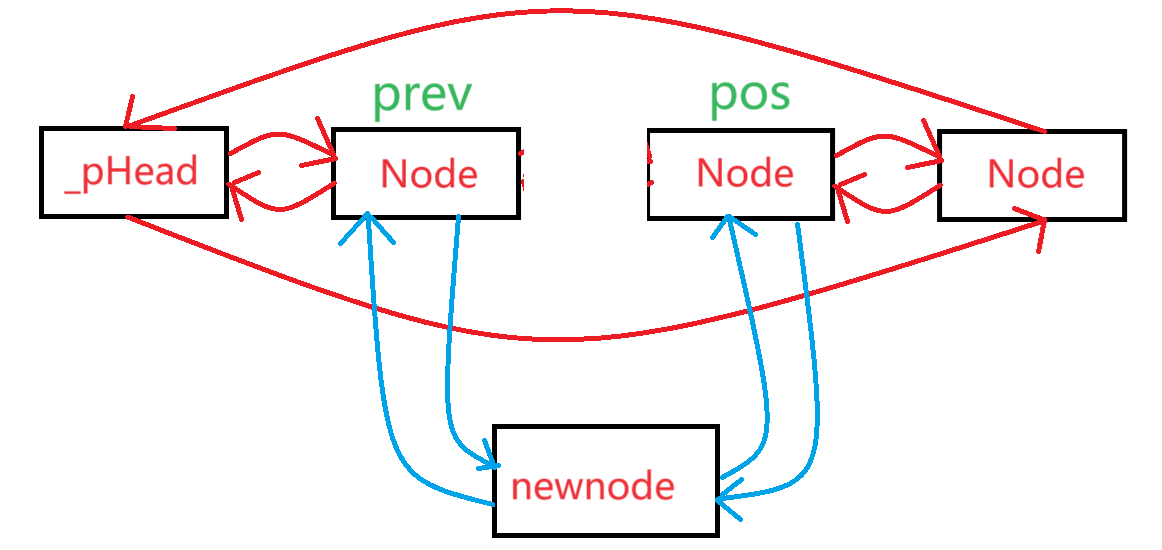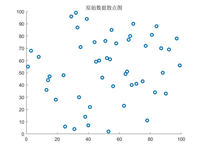hello,各位小伙伴,本篇文章跟大家一起学习《c++:list模拟实现》,感谢大家对我上一篇的支持,如有什么问题,还请多多指教 !
如果本篇文章对你有帮助,还请各位点点赞!!!

话不多说,开始进入正题
🍁list的逻辑结构以及节点代码

是一个双指针带头链表,所以我选择用一个结构体listnode来维护节点,如下:
// list的节点类
template<class t>
struct listnode
{
listnode(const t& val = t())
:_val(val)
,_ppre(nullptr)
,_pnext(nullptr)
{}
listnode<t>* _ppre;// 指向前一个结点
listnode<t>* _pnext;// 指向后一个节点
t _val;// 该结点的值
};
我对listnode<t>改一个名字:node:
typedef listnode<t> node;
typedef node* pnode;
🍁list类
🍃私有成员变量_phead和私有成员函数createhead()
private:
void createhead()// 创建头节点并且初始化
{
_phead = new node();
_phead->_pnext = _phead;
_phead->_ppre = _phead;
}
pnode _phead;
🍃尾插函数和插入函数
尾插只是插入的其中一种方式,所以实现了插入函数,就能够实现尾插函数。
插入思路图解:在pos位置前插入值为val的节点
创建新节点值为value后;
使prev节点的_pnext指针指向newnode,newnode的节点的_ppre指向prev;
使cur节点的_ppre指针指向newnode,newnode的节点的_pnext指向cur;
最后返回iterator(newnode);

itearator为迭代器,后面会实现
- 插入
// 在pos位置前插入值为val的节点
iterator insert(iterator pos, const t& val)
{
node* cur = pos._pnode;
node* newnode = new node(val);
node* prev = cur->_ppre;
// prev newnode cur
prev->_pnext = newnode;
newnode->_ppre = prev;
newnode->_pnext = cur;
cur->_ppre = newnode;
return iterator(newnode);
}
- 尾插
void push_back(const t& val)
{
insert(end(), val);
}
🍃构造函数
- 无参构造
list(const pnode& phead = nullptr)
{
createhead();
/*_phead = new node();
_phead->_pnext = _phead;
_phead->_ppre = _phead;*/
}
- 带参构造(数值)
list(int n, const t& value = t())
{
createhead();
for (int i = 0; i < n; ++i)
push_back(value);
}
- 带参构造(迭代器)
template <class iterator>
list(iterator first, iterator last)
{
createhead();
while (first != last)
{
push_back(*first);
++first;
}
}
- 拷贝构造
list(const list<t>& l)
{
createhead();
// 复用带参构造(迭代器)
list<t> temp(l.cbegin(), l.cend());
// 与*this的头节点phead交换指向
swap(temp);
}
🍃析构函数
clear()为其中的成员函数,功能:清理list中的数据
~list()
{
clear();
delete _phead;
_phead = nullptr;
/*node* cur = _phead->_pnext;
node* tmp = cur->_pnext;
while (cur != _phead)
{
delete cur;
cur = tmp;
tmp = tmp->_pnext;
}
tmp = cur = nullptr;
_phead->_pnext = _phead;
_phead->_ppre = _phead;*/
}
🍃迭代器模拟
逻辑上并不难,也许难理解于模板
//list的迭代器结构体
template<class t, class ref, class ptr>
struct listiterator
{
typedef listnode<t>* pnode;
typedef listiterator<t, ref, ptr> self;
listiterator(pnode pnode = nullptr)
:_pnode(pnode)
{}
listiterator(const self& l)
{
_pnode = l._pnode;
}
t& operator*()
{
assert(_pnode != _pnode->_pnext);
return _pnode->_val;
}
t* operator->()
{
return &(*this);
}
self& operator++()
{
_pnode = _pnode->_pnext;
return *this;
}
self operator++(int)
{
pnode* tmp = _pnode;
_pnode = _pnode->_pnext;
return tmp;
}
self& operator--()
{
_pnode = _pnode->_ppre;
return *this;
}
self& operator--(int)
{
pnode* tmp = _pnode;
_pnode = _pnode->_ppre;
return tmp;
}
bool operator!=(const self& l)
{
return _pnode != l._pnode;
}
bool operator==(const self& l)
{
return !(*this != l);
}
pnode _pnode;
};
这段代码定义了一个模板结构 listiterator,用于表示list类的迭代器。让我们来解释模板声明部分:
template<class t, class ref, class ptr>;
这一行是模板声明,定义了一个模板类 listiterator,它有三个模板参数:t、ref 和 ptr。让我们逐个解释这些参数的作用:
1.t: 这是一个模板参数,表示迭代器指向的元素类型。在使用 listiterator 时,你需要提供实际的类型作为 t 的值。
2.ref: 这也是一个模板参数,表示迭代器的引用类型。通常情况下,当你通过迭代器解引用(使用 * 运算符)时,你希望得到的是元素的引用类型。所以 ref 通常被设定为 t&,表示引用类型为 t 的元素。
3.ptr: 这是迭代器的指针类型。与 ref 类似,当你通过迭代器解引用(使用 -> 运算符)时,你希望得到的是元素的指针类型。因此,通常情况下 ptr 被设定为 t*,表示指针类型为 t 的元素。
通过将这些参数设定为模板参数,listiterator 类可以适用于不同类型的元素,同时也可以提供不同的引用和指针类型。这样做使得 listiterator 类更加灵活,能够适用于不同的使用场景。
- 封装的意义
将迭代器的实现从 list 类中分离出来,有几个重要的意义和优势:
- 模块化设计:通过将迭代器封装为单独的类,可以实现更模块化的设计。这意味着 list 类的实现与迭代器的实现可以分开,每个类都专注于自己的职责。这样的设计使得代码更易于理解、维护和测试。
- 可重用性:通过将迭代器设计为独立的类,可以在不同的容器类中重复使用相同的迭代器实现。例如,如果你有另一个类似于 list 的容器类,也需要迭代器来遍历其中的元素,你可以直接重用相同的迭代器实现,而无需重新编写。
- 灵活性:将迭代器设计为独立的类使得它们的实现更加灵活。你可以在迭代器类中添加额外的功能或改变迭代器的行为,而不会影响到容器类的实现。这样的设计使得容器和迭代器的职责分离,每个类可以独立地演化和改进。
- 通用性:独立的迭代器类可以设计成通用的,适用于多种容器类型。这意味着你可以为不同的容器类实现相同的迭代器接口,使得用户在使用不同的容器时无需学习不同的迭代器接口,提高了代码的一致性和可用性。
总的来说,将迭代器封装为独立的类使得代码更加模块化、可重用、灵活和通用,提高了代码的可维护性、可扩展性和可读性。
🍃list类中迭代器的使用
public:
typedef listiterator<t, t&, t*> iterator;
typedef listiterator<t, const t&, const t&> const_iterator;
- begin()和end()
// list iterator
iterator begin()
{
return _phead->_pnext;
}
iterator end()
{
return _phead;
}
const_iterator begin() const
{
return _phead->_pnext;
}
const_iterator end() const
{
return _phead;
}
- erase
删除pos位置的节点,返回该节点的下一个位置
iterator erase(iterator pos)
{
assert(pos._pnode != _phead);
node* prev = pos._pnode->_ppre;
node* next = pos._pnode->_pnext;
delete pos._pnode;
prev->_pnext = next;
next->_ppre = prev;
return iterator(next);
}
🍃list modify
void push_back(const t& val) { insert(end(), val); }
void pop_back() { erase(--end()); }
void push_front(const t& val)
{
assert(!empty());
insert(begin(), val);
}
void pop_front() { erase(begin()); }
🍁全部代码
#pragma once
#include<assert.h>
#include<iostream>
using namespace std;
namespace my_list
{
// list的节点类
template<class t>
struct listnode
{
listnode(const t& val = t())
:_val(val)
,_ppre(nullptr)
,_pnext(nullptr)
{}
listnode<t>* _ppre;
listnode<t>* _pnext;
t _val;
};
//list的迭代器类
template<class t, class ref, class ptr>
struct listiterator
{
typedef listnode<t>* pnode;
typedef listiterator<t, ref, ptr> self;
listiterator(pnode pnode = nullptr)
:_pnode(pnode)
{}
listiterator(const self& l)
{
_pnode = l._pnode;
}
t& operator*()
{
assert(_pnode != _pnode->_pnext);
return _pnode->_val;
}
t* operator->()
{
return &(*this);
}
self& operator++()
{
_pnode = _pnode->_pnext;
return *this;
}
self operator++(int)
{
pnode* tmp = _pnode;
_pnode = _pnode->_pnext;
return tmp;
}
self& operator--()
{
_pnode = _pnode->_ppre;
return *this;
}
self& operator--(int)
{
pnode* tmp = _pnode;
_pnode = _pnode->_ppre;
return tmp;
}
bool operator!=(const self& l)
{
return _pnode != l._pnode;
}
bool operator==(const self& l)
{
return !(*this != l);
}
pnode _pnode;
};
//list类
template<class t>
class list
{
typedef listnode<t> node;
typedef node* pnode;
public:
typedef listiterator<t, t&, t*> iterator;
typedef listiterator<t, const t&, const t&> const_iterator;
public:
///
// list的构造
list(const pnode& phead = nullptr)
{
createhead();
/*_phead = new node();
_phead->_pnext = _phead;
_phead->_ppre = _phead;*/
}
list(int n, const t& value = t())
{
createhead();
for (int i = 0; i < n; ++i)
push_back(value);
/*int cnt = 0;
while (cnt < n)
{
pnode _first = new node(value);
pnode tmp = _phead->_ppre;
tmp->_pnext = _first;
_first->_ppre = tmp;
_first->_pnext = _phead;
_phead->_ppre = _first;
++cnt;
}*/
}
template <class iterator>
list(iterator first, iterator last)
{
createhead();
while (first != last)
{
push_back(*first);
++first;
}
/*while (first != last)
{
pnode _first = new node(*first);
pnode tmp = _phead->_ppre;
tmp->_pnext = _first;
_first->_ppre = tmp;
_first->_pnext = _phead;
_phead->_ppre = _first;
++first;
}*/
}
list(const list<t>& l)
{
createhead();
list<t> temp(l.cbegin(), l.cend());
swap(temp);
/*iterator first = l._phead->_pnext;
iterator last = l._phead;
while (first != last)
{
pnode _first = new node(*first);
pnode tmp = _phead->_ppre;
tmp->_pnext = _first;
_first->_ppre = tmp;
_first->_pnext = _phead;
_phead->_ppre = _first;
++first;
}*/
}
list<t>& operator=(const list<t> l)
{
createhead();
swap(l);
return *this;
/*iterator first = l._phead->_pnext;
iterator last = l._phead;
while (first != last)
{
pnode _first = new node(*first);
pnode tmp = _phead->_ppre;
tmp->_pnext = _first;
_first->_ppre = tmp;
_first->_pnext = _phead;
_phead->_ppre = _first;
++first;
}
return *this;*/
}
~list()
{
clear();
delete _phead;
_phead = nullptr;
/*node* cur = _phead->_pnext;
node* tmp = cur->_pnext;
while (cur != _phead)
{
delete cur;
cur = tmp;
tmp = tmp->_pnext;
}
tmp = cur = nullptr;
_phead->_pnext = _phead;
_phead->_ppre = _phead;*/
}
///
// list iterator
iterator begin()
{
return _phead->_pnext;
}
iterator end()
{
return _phead;
}
const_iterator begin() const
{
return _phead->_pnext;
}
const_iterator end() const
{
return _phead;
}
///
// list capacity
size_t size()const
{
node* cur = _phead->_pnext;
size_t cnt = 0;
while (cur != _phead)
{
++cnt;
cur = cur->_pnext;
}
return cnt;
}
bool empty()const
{
return size() == 0;
}
// list access
t& front()
{
return _phead->_pnext->_val;
}
const t& front()const
{
return _phead->_pnext->_val;
}
t& back()
{
return _phead->_ppre->_val;
}
const t& back()const
{
return _phead->_ppre->_val;
}
// list modify
void push_back(const t& val) { insert(end(), val); }
void pop_back() { erase(--end()); }
void push_front(const t& val)
{
assert(!empty());
insert(begin(), val);
}
void pop_front() { erase(begin()); }
// 在pos位置前插入值为val的节点
iterator insert(iterator pos, const t& val)
{
node* cur = pos._pnode;
node* newnode = new node(val);
node* prev = cur->_ppre;
// prev newnode cur
prev->_pnext = newnode;
newnode->_ppre = prev;
newnode->_pnext = cur;
cur->_ppre = newnode;
return iterator(newnode);
}
// 删除pos位置的节点,返回该节点的下一个位置
iterator erase(iterator pos)
{
assert(pos._pnode != _phead);
node* prev = pos._pnode->_ppre;
node* next = pos._pnode->_pnext;
delete pos._pnode;
prev->_pnext = next;
next->_ppre = prev;
return iterator(next);
}
void clear()
{
iterator cur = begin();
while (cur != end())
{
cur = erase(cur);
}
_phead->_pnext = _phead;
_phead->_ppre = _phead;
}
void swap(list<t>& l)
{
/*list<t> tmp = l;
l = *this;
*this = tmp;*/
pnode tmp = _phead;
_phead = l._phead;
l._phead = tmp;
}
private:
void createhead()
{
_phead = new node();
_phead->_pnext = _phead;
_phead->_ppre = _phead;
}
pnode _phead;
};
};
你学会了吗?
好啦,本章对于《c++:list模拟实现》的学习就先到这里,如果有什么问题,还请指教指教,希望本篇文章能够对你有所帮助,我们下一篇见!!!
如你喜欢,点点赞就是对我的支持,感谢感谢!!!




发表评论